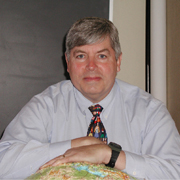|
|
Cataclysms on the Columbia, the Great Missoula FloodsScott Burns Wednesday, March 21st, 2012 |
||
|
|||
|
One of the greatest set of geological events to ever have occurred in North America was given the name, the Missoula Floods. The floods originated when an ice dam broke in upper Idaho liberating waters impounded in back of it in Montana, scouring out large sections of eastern Washington and the lower Columbia River drainage basin. The talk will focus on the incredible story of discovery and development of the idea of the floods by J Harlen Bretz and later geologists and then will discuss the effect of the floods on the development of the landscape of 16,000 square miles of the Pacific Northwest. The floods occurred between 15,000 and 18,000 years ago. The idea of older floods will also be included.
|
|||
 |
The acclaimed book, Cataclysms on the Columbia: the Great Missoula FloodsAllen, J.E., Burns, M., Burns, S.F. (2009) Cataclysms on the Columbia, The Great Missoula Floods (revised Second Edition), Ooligan Press, 204 pages |
||
| Dr. Scott Burns has been named the 2011-2012 Richard H. Jahns Distinguished Lecturer in Engineering Geology. Scott is a Professor of Geology at Portland State University (PSU) where he specializes in environmental and engineering geology, soils, geomorphology, Quaternary Geology and terroir. He has B.S. and M.S. degrees from Stanford University, plus a Ph.D. from the University of Colorado. Scott holds registrations in Oregon (RG and CEG) and a license in Washington (LG). Scott also is a consultant and an expert witness for law cases. He just finished his 21st year of teaching there and his 41st year of teaching at the university level (previous positions in Switzerland, New Zealand, Washington, Colorado and Louisiana). An author or co-author of two books, over 80 articles, and over 200 published abstracts, Scott has worked on research topics as diverse as landslide, debris flow, radon and earthquake hazard mapping, heavy metals and trace elements in soils, loess stratigraphy, slope stability, Missoula Floods, bio-geomorphology (pocket gophers, tree throw, and ants), alpine soil development, and terroir (relationship of geology, soils, climate and wine). He was president of AEG (2002-2003) and vice president (North America) for IAEG (2006-2010). He has received the the Public Service Award from GSA in 2011 and the Meritorius Service Award (2006) from the Engineering Geology Division (EGD) of Geological Society of America. He has been the Chair of the Engineering Geology Division and the Treasurer of the Quaternary Geology and Geomorphology Division (for 12 years) of GSA. Scott has been an Associate Dean, chair of departments and president of faculty senates at three different universities, and president of one of the largest and oldest Rotary clubs in the world. Scott has won many awards for outstanding teaching with the most significant being the Faculty Senate Chair Award at Louisiana Tech University in 1987, the Distinguished Faculty Award from the PSU Alumni Association in 2001, and the George Hoffmann Award from PSU in 2007. He actively helps local TV and radio stations and newspapers bring important geological news to the public. The Jahns lectureship, established in 1988, is sponsored by the Association of Environmental and Engineering Geologists and the GSA Engineering Geology Division. Its purpose is to provide funding for distinguished engineering geologists to present lectures at colleges and universities in order to increase awareness of students about careers in engineering geology. The lectureship is named in honor of Dr. Richard H. Jahns (1915-1983), an engineering geologist who had a diverse and distinguished career in academia, consulting and government. | |||


